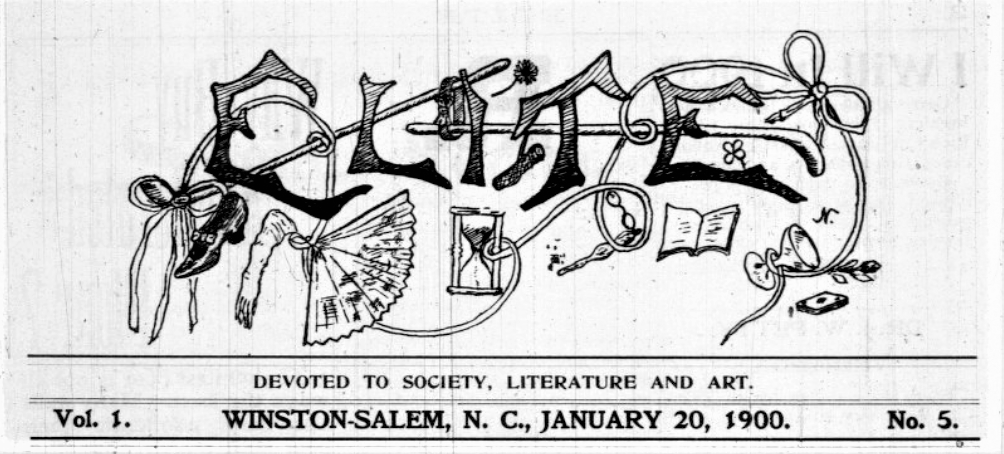
This week we’ve added another 60 titles to DigitalNC. Included in this batch is the possible origin of a classic North Carolina ghost story!
The Maco Light story tells of a train conductor name Joe Baldwin who was decapitated in a tragic railway accident near the small community of Maco, North Carolina. Legend has it that the ghost of Mr. Baldwin could be seen walking the tracks at night, carrying a lantern and searching for his misplaced head, but once the railroad was removed in the 1970s he was never seen again.
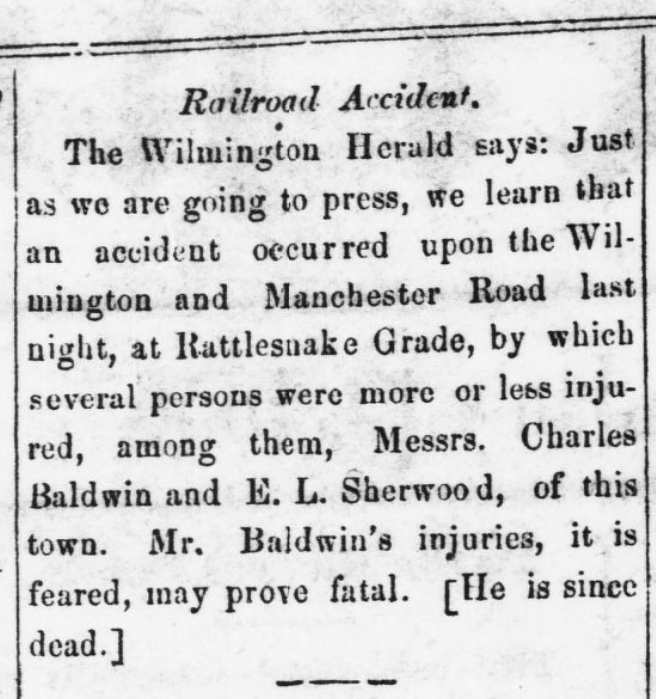
The Southerner, January 12, 1856
As is the case with most folk tales, the story is passed down and embellished over the years and the origin becomes a little fuzzy. There is no record of a “Joe” Baldwin being involved in a wreck, but the January 12th, 1856 issue of The Southerner has an article detailing a train accident that took place just outside of Wilmington a week earlier. The deceased in this incident is Charles Baldwin, who suffered a fatal head injury during the crash. Given the similarities in these stories, it seems our ghost might have actually stayed in one piece.
Over the next year, we’ll be adding millions of newspaper images to DigitalNC. These images were originally digitized a number of years ago in a partnership with Newspapers.com. That project focused on scanning microfilmed papers published before 1923 held by the North Carolina Collection in Wilson Special Collections Library. While you can currently search all of those pre-1923 issues on Newspapers.com, over the next year we will also make them available in our newspaper database as well. This will allow you to search that content alongside the 2 million pages already on our site – all completely open access and free to use.
This week’s additions include:
Elizabeth City
Greensboro
Hendersonville
Oxford
Rutherfordton
Salem
Salisbury
Southern Pines
Southport
Tarboro
Taylorsville
Warrenton
Washington
- The Republican (Washington, N.C.) – 1839
- Rough and Ready (Washington, N.C.) – 1848
- The Statesman, and Third Congressional District Advertiser (Washington, N.C.) – 1834-1835
- North Carolina Times (Washington, N.C.) – 1856-1860
- The Union Advance Picket (Washington, N.C.) – 1862
- The Eastern Intelligencer (Washington, N.C.) – 1869
- The Union (Washington, N.C.) – 1832
- What Next (Washington, N.C.) – 1876
- Washington Dispatch (Washington, N.C.) – 1857-1861
- Washington Herald (Washington, N.C.) – 1827
- Washington Index (Washington, N.C.) – 1867
- The Washington Gazette (Washington, N.C.) – 1884-1898
Williamston
Wilson
- The North Carolinian (Wilson, N.C.) – 1867-1868
- The Daily News (Wilson, N.C.) – 1900-1901
- The Wilson Ledger (Wilson, N.C.) – 1858-1861
- The Flag of the South (Wilson, N.C.) – 1861
- The Advertiser (Wilson, N.C.) – 1888
- The Advance (Wilson, N.C.) – 1874-1876
- The Wilson News (Wilson, N.C.) – 1899
- The Daily Topic (Wilson, N.C.) – 1873
- Southern Sentinel (Wilson, N.C.) – 1856
- The Little Jewel (Wilson, N.C.) – 1875
Winston
Winston-Salem
If you want to see all of the newspapers we have available on DigitalNC, you can find them here. Thanks to UNC-Chapel Hill Libraries for permission to and support for adding all of this content as well as the content to come. We also thank the North Caroliniana Society for providing funding to support staff working on this project.

This week we have another 61 titles up on DigitalNC, including our first additions from Charleston, Culler, Red Springs, Rutherfordton, and Sanford! Included in this batch, on the front page of the February 28, 1872 issue of Raleigh’s Weekly Sentinel, is an article detailing the final heist of Robeson County folk hero Henry Berry Lowry.
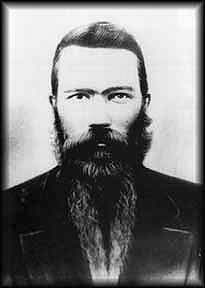
Portrait thought to be of Henry Berry Lowry. Via the State Archives of North Carolina
Henry Berry Lowry, a Lumbee Native American, was the head of the mostly Native outlaw group known as the Lowry Gang. In addition to typical outlaw activities, the Lowry Gang also helped other Native Americans avoid Confederate work conscription and fought alongside Union soldiers who had escaped Confederate prison camps. While Lowry did often resort to murder to settle personal feuds, he was also considered a sort of Robeson “Robin Hood.” When they committed robberies, they would often share the spoils with the community and would return items such as horses as soon as they were no longer needed. They were known to be “respectful” robbers and would let you off the hook if you could show you didn’t have much.
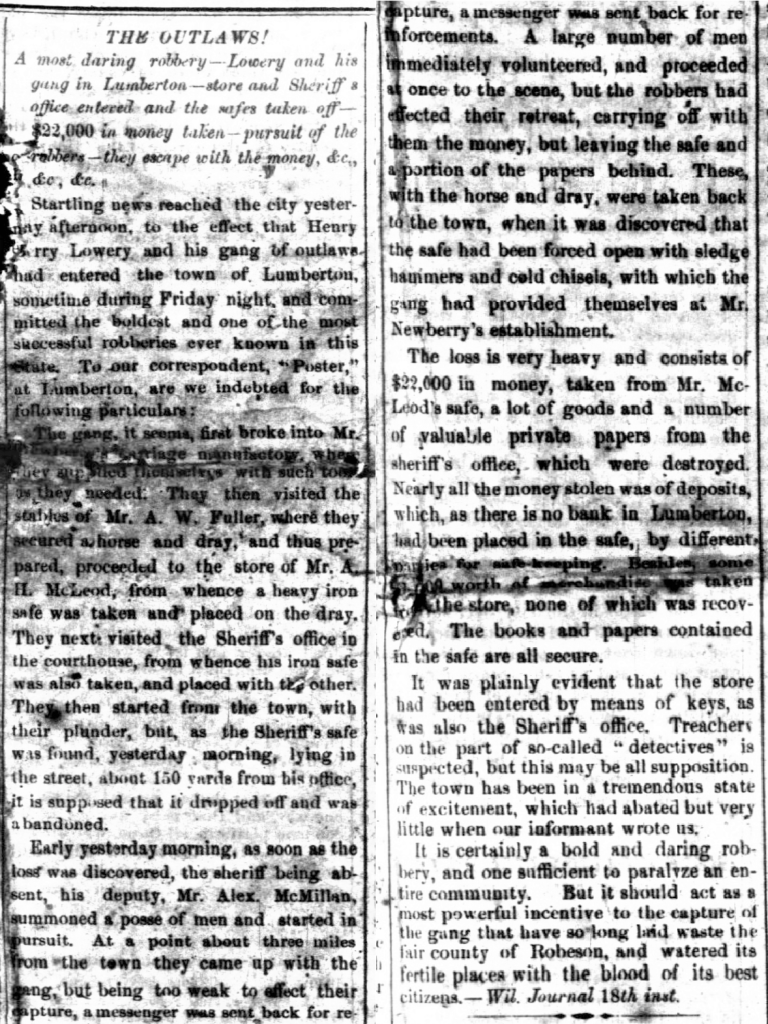
The Weekly Sentinel, February 28, 1872
In 1869, governor William Holden put a $12,000 bounty on Lowry’s head, which resulted in bloody conflict over the next few years. After successfully evading capture, Lowry planned his final heist in February of 1872. The gang stole a safe from a local carriage manufacturer and were bold enough to take another from the sheriff’s office, walking away with $22,000 (about $520,000 today) and then he disappeared. The bounty was never collected and he was never heard from again. Some locals claim they saw him at a friend’s funeral years later, but we will likely never know what happened to Henry Berry Lowry.
Over the next year, we’ll be adding millions of newspaper images to DigitalNC. These images were originally digitized a number of years ago in a partnership with Newspapers.com. That project focused on scanning microfilmed papers published before 1923 held by the North Carolina Collection in Wilson Special Collections Library. While you can currently search all of those pre-1923 issues on Newspapers.com, over the next year we will also make them available in our newspaper database as well. This will allow you to search that content alongside the 2 million pages already on our site – all completely open access and free to use.
This week’s additions include:
Asheboro
Charleston
Charlotte
Culler
Elizabeth City
Goldsboro
Greensboro
Halifax
Hertford
North Wilkesboro
Oxford
Plymouth
Raleigh
Red Springs
Reidsville
Rockingham
Rutherfordton
Salisbury
Sanford
Shelby
Tarboro
Taylorsville
Wadesboro
Warrenton
Washington
Winston-Salem
If you want to see all of the newspapers we have available on DigitalNC, you can find them here. Thanks to UNC-Chapel Hill Libraries for permission to and support for adding all of this content as well as the content to come. We also thank the North Caroliniana Society for providing funding to support staff working on this project.

This week we have another 34 titles up on DigitalNC! In this batch we have an article from the Durham Tobacco Plant describing the construction of a new factory being built by W. Duke, Sons & Co., which contained a machine that would revolutionize their tobacco business: The Bonsack machine.

Durham Tobacco Plant, July 16, 1884
In 1881, Virginia native James Bonsack created the first industrial cigarette rolling machine, a task that was done meticulously by hand up until this point. Bonsack partnered with W. Duke, Sons & Co. in 1884 and supplied them with one of his machines that could roll 250,000 cigarettes in a single day, the equivalent of 48 employees. While this acquisition would make the Dukes the leading cigarette producer in the country, the automation of the process forced many skilled rollers out of work.
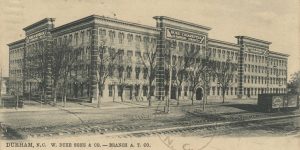
W. Duke, Sons & Co. 1884 factory. Image via opendurham.org
Over the next year, we’ll be adding millions of newspaper images to DigitalNC. These images were originally digitized a number of years ago in a partnership with Newspapers.com. That project focused on scanning microfilmed papers published before 1923 held by the North Carolina Collection in Wilson Special Collections Library. While you can currently search all of those pre-1923 issues on Newspapers.com, over the next year we will also make them available in our newspaper database as well. This will allow you to search that content alongside the 2 million pages already on our site – all completely open access and free to use.
This week’s additions include:
- The North Carolinian (Elizabeth City, N.C.) – 1869-1903
- The Yadkin Valley News (Mt. Airy, N.C.) – 1880-1895
- The Index (Wilkesboro, N.C.) – 1880-1881
- The News Reporter (Whiteville, N.C.) – 1912-1924
- The Montgomery Vidette (Troy, N.C.) – 1886-1891
- The Southern Vidette (Norwood, N.C.) – 1891-1892
- Carter’s Weekly (North Wilkesboro, N.C.) – 1920-1922
- The Alexander County Journal (Taylorsville, N.C.) – 1887-1888
- Washington Progress (Washington, N.C.) – 1892-1913
- The Chronicle (Wilkesboro, N.C.) – 1890-1911
- The Wilson Mirror (Wilson, N.C.) – 1887-1894
- Windsor Public Ledger (Windsor, N.C.) – 1887-1889
- Windsor Ledger (Windsor, N.C.) – 1889-1915
- The Daily Southerner (Tarboro, N.C.) – 1889-1922
- The Carolina Mountaineer and Waynesville Courier (Waynesville, N.C.) – 1917-1923
- Raleigh Christian Advocate (Raleigh, N.C.) – 1914
- The Elizabeth-City Star (Elizabeth City, N.C.) – 1822-1824
- The Elizabeth-City Star and North-Carolina Eastern Intelligencer (Elizabeth City, N.C.) – 1825-1833
- The North-Carolinian (Fayetteville, N.C.) – 1839-1864
- The Greensboro Patriot (Greensboro, N.C.) – 1888
- Durham Tobacco Plant (Durham, N.C.) – 1872-1885
- The Enquirer (Tarboro, N.C.) – 1871-1873
- The Times (Greensboro, N.C.) – 1856-1861
- Halifax Compiler (Halifax, N.C.) – 1818
- Halifax Minerva (Halifax, N.C.) – 1829-1830
- The Edenton Gazette, and North-Carolina Advertiser (Edenton, N.C.) – 1806-1809
- The Edenton Gazette (Edenton, N.C.) – 1809-1813
- The Edenton Gazette, and North-Carolina General Advertiser (Edenton, N.C.) – 1814-1822
- Edenton Gazette (Edenton, N.C.) – 1827-1831
- The N.C. Republican, and Civil Rights Advocate (Weldon, N.C.) – 1884
- The Weldon Patriot (Weldon, N.C.) – 1852-1859
- Railroad Ticket (Weldon, N.C.) – 1881
- The Semi-Weekly State (Weldon, N.C.) – 1867
- Webster’s Weekly (Reidsville, N.C.) – 1881-1916
If you want to see all of the newspapers we have available on DigitalNC, you can find them here. Thanks to UNC-Chapel Hill Libraries for permission to and support for adding all of this content as well as the content to come. We also thank the North Caroliniana Society for providing funding to support staff working on this project.
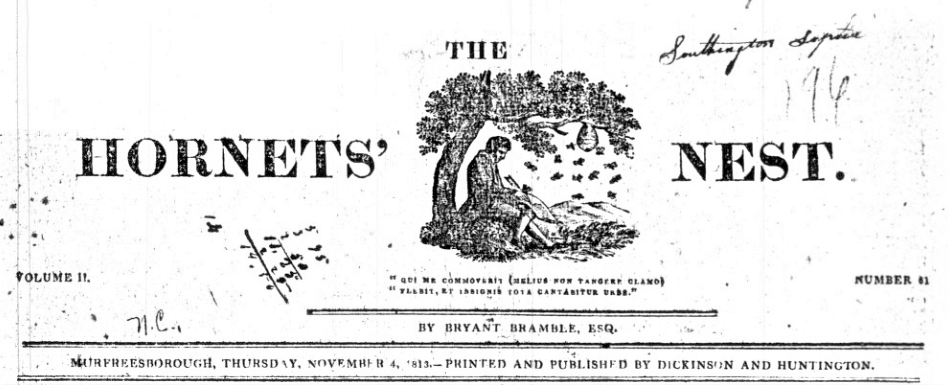
This week we have another 60 titles from all over the state up on DigitalNC, including a little piece of North Carolina railroad history!
On the second page of the January 15th, 1833 issue of the Fayetteville Observer, you’ll find a list of all the legislation enacted by the North Carolina General Assembly during the 1832-1833 session. One of these acts is the incorporation of the company that built North Carolina’s first functional railroad: The Experimental Rail Road Company of Raleigh.
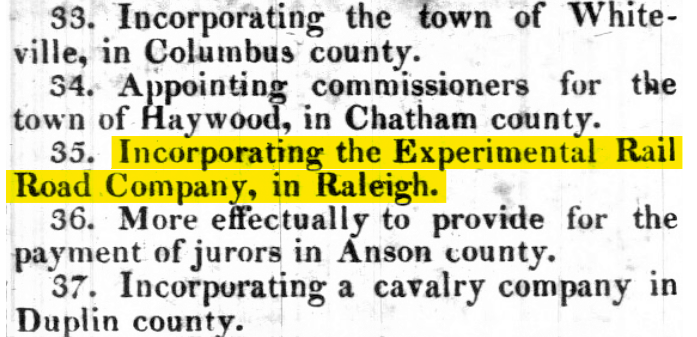
Fayetteville Observer, January 15, 1833
The one and one-quarter mile rail line extended from the Capitol Building, which had burned in 1831, to a quarry just east of Raleigh. When the horse-drawn rail carts weren’t transporting the stone used to rebuild the Capitol, people could ride the line in “pleasure cars” for a 25 cent fare. The line cost $2,700 to construct, which would be roughly $91,000 in 2022.
Over the next year, we’ll be adding millions of newspaper images to DigitalNC. These images were originally digitized a number of years ago in a partnership with Newspapers.com. That project focused on scanning microfilmed papers published before 1923 held by the North Carolina Collection in Wilson Special Collections Library. While you can currently search all of those pre-1923 issues on Newspapers.com, over the next year we will also make them available in our newspaper database as well. This will allow you to search that content alongside the 2 million pages already on our site – all completely open access and free to use.
This week’s additions include:
- The North Carolina Prohibitionist (Bush Hill, N.C.) – 1886-1888
- The Progress (Enfield, N.C.) – 1908-1922
- The North-Carolina Journal (Halifax, N.C.) – 1792-1810
- The News Reporter (Littleton, N.C.) – 1897-1923
- The Franklin Courier (Louisburg, N.C.) – 1872-1874
- The Madison Enterprise (Madison, N.C.) – 1873-1874
- The Monroe Journal (Monroe, N.C.) – 1923
- The Iredell Gazette (Mooresville, N.C.) – 1880
- The Morganton Herald (Morganton, N.C.) – 1891-1901
- Surry Visitor (Mount Airy, N.C.) – 1874-1876
- Cherokee Herald (Murphy, N.C.) – 1874-1876
- Person County Courier (Roxboro, N.C.) – 1890-1892
- North Carolina Argus (Wadesboro, N.C.) – 1848-1876
- Mecklenburg Times (Charlotte, N.C.) – 1889-1897
- The North Carolina Whig (Charlotte, N.C.) – 1863
- King’s Dollar Daily (Greenville, N.C.) – 1904
- King’s Weekly (Greenville, N.C.) – 1894-1909
- McDowell Democrat (Marion, N.C.) – 1905-1909
- Marion Progress (Marion, N.C.) – 1909-1922
- The Stanly Banner (Albemarle, N.C.) – 1876
- The Stanly Observer (Albemarle, N.C.) – 1884
- The Stanly News (Albemarle, N.C.) – 1892-1893
- The Caldwell Messenger (Lenoir, N.C.) – 1875-1876
- The Semi-Weekly News (Lenoir, N.C.) – 1900
- The Weekly News (Lenoir, N.C.) – 1900-1902
- The Magnolia Monitor (Magnolia, N.C.) – 1873-1876
- The Duplin Record (Magnolia, N.C.) – 1874-1875
- The Weekly Record (Magnolia, N.C.) – 1876-1877
- The Central (Lexington, N.C.) – 1876
- Lexington and Yadkin Flag (Lexington, N.C.) – 1855-1856
- The Lexington Herald (Lexington, N.C.) – 1915-1917
- The North State (Lexington, N.C.) – 1904-1908
- Murfreesboro Enquirer (Murfreesboro, N.C.) – 1876-1878
- The Albemarle Enquirer (Murfreesboro, N.C.) – 1878-1881
- The Hornets’ Nest (Murfreesboro, N.C.) – 1812-1813
- Carolina Chronicle (Murfreesboro, N.C.) – 1827
- Milton Intelligencer (Milton, N.C.) – 1819
- Milton Spectator (Milton, N.C.) – 1832-1839
- The Milton Chronicle (Milton, N.C.) – 1841-1888
- Milton Gazette & Roanoke Advertiser (Milton, N.C.) – 1824-1831
- The Milton Spectator (Milton, N.C.) – 1854
- The Lincoln Democrat (Lincolnton, N.C.) – 1895-1896
- The Lincoln Journal (Lincolnton, N.C.) – 1898-1901
- The Lincoln Courier (Lincolnton, N.C.) – 1891
- Lincoln Transcript (Lincolnton, N.C.) – 1836
- The Western Whig Banner (Lincolnton, N.C.) – 1840
- Lincoln Progress (Lincolnton, N.C.) – 1873-1882
- Economist (Elizabeth City, N.C.) – 1903
- The Weekly Economist (Elizabeth City, N.C.) – 1903-1905
- Daily Economist (Elizabeth City, N.C.) – 1905-1907
- North Carolina Advocate (Elizabeth City, N.C.) – 1833
- The Intelligencer, and Nag’s Head Advocate (Elizabeth City, N.C.) – 1840-1841
- The Elizabeth-City Gazette, and Public Advertiser (Elizabeth City, N.C.) – 1808
- Fayetteville Observer (Fayetteville, N.C.) – 1833
- The Public Spirit (Fayetteville, N.C.) – 1876
- The News (Fayetteville, N.C.) – 1865
- The Fayetteville Daily News (Fayetteville, N.C.) – 1865
- The Weekly Courier (Fayetteville, N.C.) – 1860
- Fayetteville Examiner (Fayetteville, N.C.) – 1880-1883
- Daily Telegraph (Fayetteville, N.C.) – 1865
If you want to see all of the newspapers we have available on DigitalNC, you can find them here. Thanks to UNC-Chapel Hill Libraries for permission to and support for adding all of this content as well as the content to come. We also thank the North Caroliniana Society for providing funding to support staff working on this project.

This week we have another 41 titles up on DigitalNC! In this batch we have a lot of new papers from Durham and Beaufort, as well as our first additions from Mocksville, Pine Forest, and Kenansville!
Last month we added our first copies of The Nation from Buffalo Springs. The Nation was a handwritten paper published by John McLean Harrington, a Harnett County man who would painstakingly copy each of his papers by hand for his roughly 100 subscribers. This week we have five more of Harrington’s handwritten papers: The Young American from Buffalo Springs, The Weekly Eagle from Pine Forest, and Harrington, N.C.’s The Times, The Weekly News, and The Semi-Weekly News.
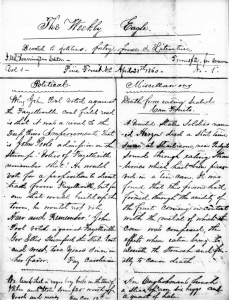
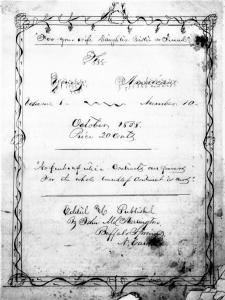
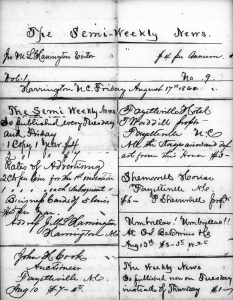
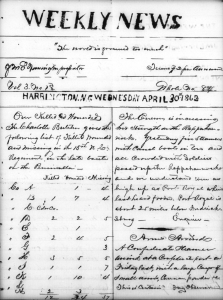
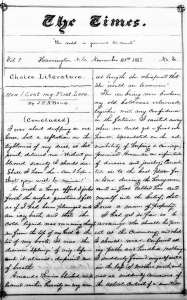
Over the next year, we’ll be adding millions of newspaper images to DigitalNC. These images were originally digitized a number of years ago in a partnership with Newspapers.com. That project focused on scanning microfilmed papers published before 1923 held by the North Carolina Collection in Wilson Special Collections Library. While you can currently search all of those pre-1923 issues on Newspapers.com, over the next year we will also make them available in our newspaper database as well. This will allow you to search that content alongside the 2 million pages already on our site – all completely open access and free to use.
This week’s additions include:
- The Clinton Independent (Clinton, N.C.) – 1856-1858
- Eastern Courier (Hertford, N.C.) – 1895-1896
- The Nation (Buffalo Springs, N.C.) – 1858
- The Young American (Buffalo Springs, N.C.) – 1858
- The Weekly Eagle (Pine Forest, N.C.) – 1860
- The Eagle (Fayetteville, N.C.) – 1868-1873
- The Semi-Weekly News (Harrington, N.C.) – 1860
- The Weekly News (Harrington, N.C.) – 1860-1864
- The Times (Harrington, N.C.) – 1867-1869
- Eastern Carolina News (Kenansville, N.C.) – 1908-1911
- The Chronicle (Albemarle, N.C.) – 1916-1917
- The Enterprise (Albemarle, N.C.) – 1917-1918
- The Albemarle Enterprise (Albemarle, N.C.) – 1919
- The News (Albemarle, N.C.) – 1919
- Stanly County Herald (Albemarle, N.C.) – 1919
- The Stanly News-Herald (Albemarle, N.C.) – 1919
- The Weekly Record (Beaufort, N.C.) – 1887-1888
- The Beaufort Eagle (Beaufort, N.C.) – 1876
- The Herald (Beaufort, N.C.) – 1893
- Beaufort Journal (Beaufort, N.C.) – 1857-1858
- Carteret County Telephone (Beaufort, N.C.) – 1881-1885
- The Clayton Bud (Clayton, N.C.) – 1883-1886
- The Weekly Bud (Smithfield, N.C.) – 1886-1887
- Creedmoor Times-News (Creedmoor, N.C.) – 1915-1919
- Durham Daily Dispatch (Durham, N.C.) – 1880
- The Durham Herald (Durham, N.C.) – 1876
- The Durham County Republican (Durham, N.C.) – 1884
- The Truth (Durham, N.C.) – 1884
- Daily Record (Durham, N.C.) – 1898
- The Daily Reporter (Durham, N.C.) – 1885
- The Durham Weekly Globe (Durham, N.C.) – 1889-1892
- Durham Globe (Durham, N.C.) – 1895-1896
- Saturday Night (Durham, N.C.) – 1893
- The Patriot (Greensboro, N.C.) – 1826-1827
- The Carolina Beacon (Greensboro, N.C.) – 1836-1837
- Southern Telescope (Greensboro, N.C.) – 1837
- The Carolina Patriot (Greensboro, N.C.) – 1837-1839
- The Davie Times (Mocksville, N.C.) – 1887-1903
- The Davie Record (Mocksville, N.C.) – 1899-1922
- Chatham Observer (Pittsboro, N.C.) – 1901-1904
- Chatham Citizen (Pittsboro, N.C.) – 1897-1899
- The Day (Oxford, N.C.) – 1890-1892
- The Concord Times (Concord, N.C.) – 1895-1897
- The Evening Tribune (Concord, N.C.) – 1904-1910
- Concord Daily Tribune (Concord, N.C.) – 1910-1921
If you want to see all of the newspapers we have available on DigitalNC, you can find them here. Thanks to UNC-Chapel Hill Libraries for permission to and support for adding all of this content as well as the content to come. We also thank the North Caroliniana Society for providing funding to support staff working on this project.

This week we have added issues from 35 different newspaper titles! One of the titles we have is a paper from the now non-existent town of Buffalo Springs, North Carolina. According to this News & Record article, the Harnett County town ceased to exist when the turpentine industry in the area died out. But the intriguing thing about these papers isn’t the ghost of this town, it’s the man who wrote them: John McLean Harrington. Professor and author Michael Ray Smith penned this fascinating paper about Harrington and his newspapers, in which he writes: “Shortly before the Civil War, the son of an affluent Southern family began a journalism career unlike any in his community, his state, or even the nation and produced 305 handwritten newspapers, perhaps the greatest single output of handwritten newspapers by any American journalist.” Harrington had a subscription list of roughly 100 people and would painstakingly copy each individual paper by hand, even though printing presses were widely available at the time. In 1858, when Harrington was writing issues of The Nation, he was only 19 years old. The young man’s ambitions didn’t stop with just being a journalist. He also apparently worked as a bookkeeper, surveyor, educator, sheriff, and postmaster in Harnett County. While his accomplishments were quite impressive, he was also a man of contradiction. Smith writes this of the rural Renaissance man: “He talked of a partner but never revealed the colleague’s identity—if he indeed had one. He discussed the evil of drinking but died an alcoholic. He served as a member of the Confederate militia only to swear an oath that he would always remain a loyal Unionist. Perhaps Harrington tended to do or say whatever was expedient or expected at the time. Maybe he was himself just conflicted in numerous ways.”
Over the next year, we’ll be adding millions of newspaper images to DigitalNC. These images were originally digitized a number of years ago in a partnership with Newspapers.com. That project focused on scanning microfilmed papers published before 1923 held by the North Carolina Collection in Wilson Special Collections Library. While you can currently search all of those pre-1923 issues on Newspapers.com, over the next year we will also make them available in our newspaper database as well. This will allow you to search that content alongside the 2 million pages already on our site – all completely open access and free to use.
This week’s additions include:
- The Tri-Weekly Bulletin (Charlotte, N.C.) – 1865-1881
- Asheville Pioneer (Asheville, N.C.) – 1867-1869
- Weekly Pioneer (Asheville, N.C.) – 1870-1874
- The Carolina Eagle (Hickory, N.C.) – 1871-1872
- Mountain Messenger (Jefferson, N.C.) – 1873
- Battleboro Advance (Rocky Mount, N.C.) – 1871-1873
- The Weekly Ansonian (Polkton, N.C.) – 1876-1877
- The Southern Mail (Hillsborough, N.C.) – 1880
- The Carolina Republican (Lincolnton, N.C.) – 1848-1853
- Yadkin & Catawba Journal (Salisbury, N.C.) – 1828-1833
- The Journal (Salisbury, N.C.) – 1833-1834
- The Hornet (Bixby, N.C.) – 1908
- The Courier (Asheboro, N.C.) – 1922-1924
- The Asheville Democrat (Asheville, N.C.) – 1889-1891
- Monthly Gleaner (Asheville, N.C.) – 1894-1895
- Fuller’s Gleaner (Asheville, N.C.) – 1895-1896
- The Dispatch (Bessemer City, N.C.) – 1912
- The Carthage Blade (Carthage, N.C.) – 1887-1895
- The Central Times (Dunn, N.C.) – 1895
- County Union (Dunn, N.C.) – 1895-1899
- The Transylvania Hustler (Brevard, N.C.) – 1893
- The Brevard Hustler (Brevard, N.C.) – 1896
- The Western Carolina Democrat (Bakersville, N.C.) – 1888
- Roan Mountain Republican (Bakersville, N.C.) – 1876-1879
- The Nation (Buffalo Springs, N.C.) – 1858
- Cape Fear News (Fayetteville, N.C.) – 1915-1917
- Central Argus (Hamlet, N.C.) – 1880
- The Stanly Enterprise (Albemarle, N.C.) – 1903-1907
- The Albemarle Enterprise (Albemarle, N.C.) – 1912-1916
- The Stanly News-Herald (Albemarle, N.C.) – 1920-1922
- The Beaufort News (Beaufort, N.C.) – 1920-1922
- The State Dispatch (Burlington, N.C.) – 1908-1909
- Daily Carolina Times (Charlotte, N.C.) – 1864-1869
- The Standard (Concord, N.C.) – 1900-1902
- The Battleboro Progress (Battleboro, N.C.) – 1880
If you want to see all of the newspapers we have available on DigitalNC, you can find them here. Thanks to UNC-Chapel Hill Libraries for permission to and support for adding all of this content as well as the content to come. We also thank the North Caroliniana Society for providing funding to support staff working on this project.
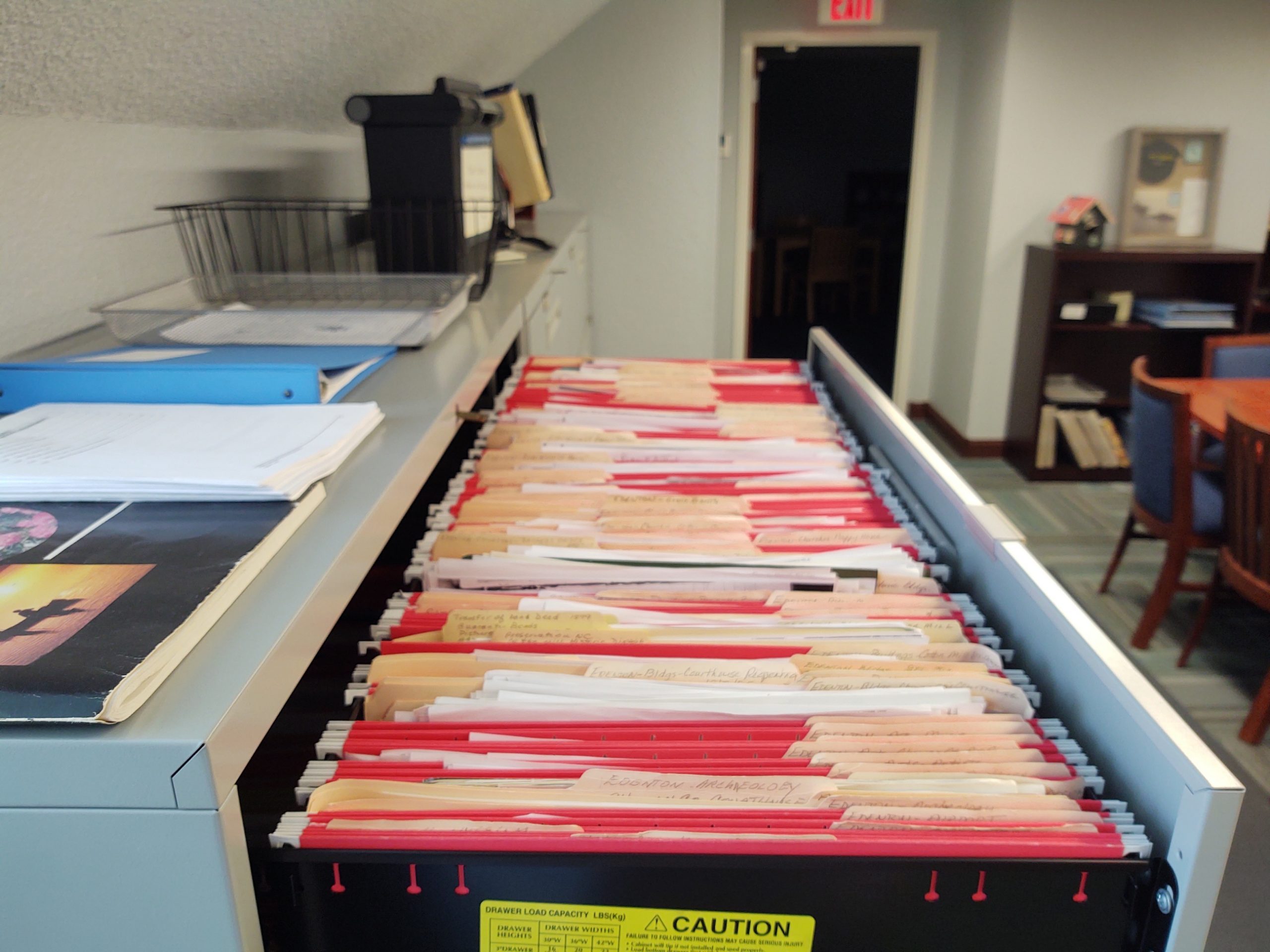 Vertical files are groups of subject-based materials often compiled over time to help an organization’s staff with frequent reference questions or research. Like the example above at Shepard-Pruden Library in Edenton, NC, they’re typically housed in filing cabinets. They are a good place to store items that wouldn’t necessarily be cataloged or accessioned (individually and formally documented by the institution) but are valuable for research. Inside you might find photographs, clippings, family trees, pamphlets, handwritten notes – but because the contents accumulate over time you can find any number of surprises inside.
Vertical files are groups of subject-based materials often compiled over time to help an organization’s staff with frequent reference questions or research. Like the example above at Shepard-Pruden Library in Edenton, NC, they’re typically housed in filing cabinets. They are a good place to store items that wouldn’t necessarily be cataloged or accessioned (individually and formally documented by the institution) but are valuable for research. Inside you might find photographs, clippings, family trees, pamphlets, handwritten notes – but because the contents accumulate over time you can find any number of surprises inside.
Vertical files are also the worst – for digitization that is. The same thing that makes them valuable for research – their convenience, their long term growth, and the variety of contents – makes them incredibly challenging to scan. If you’re interested in digitizing vertical files, we have suggestions! These have been compiled from our own experience at NCDHC along with the experiences of a number of our partners who kindly responded to a recent email asking for advice.
When facing full filing cabinets you may be tempted to dive in right at the beginning and get going, but we always suggest starting with a pilot project using a subset of materials. We can’t emphasize this enough! It’ll give you a sense of workflow, help you establish how you’re going to name and organize the scanned files, and uncover obstacles you didn’t anticipate. If it goes poorly, you can back out without losing a large investment. The suggestions below can be used for a pilot and for a full-fledged project.
Suggestion 1: Prep First, Thank Yourself Later
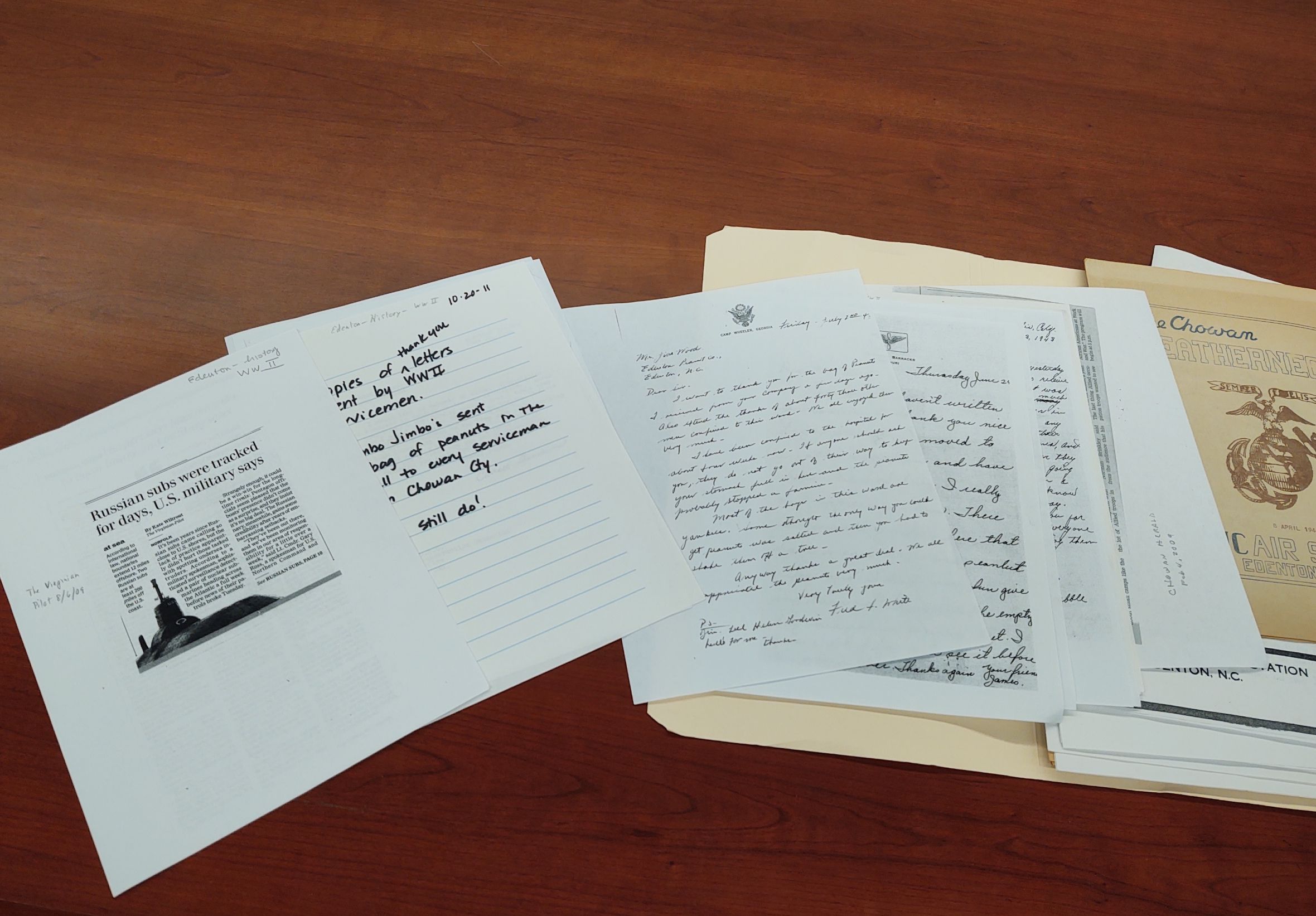
Here’s an example of a vertical file with newspaper clippings, letters, and publications about World War II. From the collection at Shepard-Pruden Library in Edenton.
Scan it all or be selective? Decide if you want to go from beginning to end or to be selective about what you’ll scan. There’s no right answer but each way has ups and downs. This decision will be subject to your users’ needs and your local resources.
Scan it all? Is there enough high value and unique content in your vertical files to warrant scanning everything? For example, some newspaper titles have been digitized in their entirety and are full text searchable (like those available at DigitalNC or Chronicling America) so you might decide that scanning clippings from those same papers is superfluous. As another example, many books published before 1924 in the United States are available online at the Internet Archive or through a simple search in your internet browser. If your files have a lot of book excerpts you may want to skip those.
Be selective? Being selective can be more time consuming and you may unintentionally miss items that would be of use, but it can be appropriate if you’re trying to simply scan items related to one or two topics or for a particular event. It is also a great option if you don’t have a lot of time or resources but want to help give access to high demand files.
First pass for organization. Go through the files in a first pass, during which you’ll assess the files’ contents, sort them in a way that will make scanning easier, and prepare the different formats for scanning. Here are some tasks to complete as you make a first pass:
- Pull out items to be cataloged separately. As your organization’s collection strategies have changed over time you may find materials within the files that should be pulled out and cataloged or accessioned independently. For example, perhaps you are a library where pamphlets were previously stuck in vertical files but are now cataloged and put on the shelf. These can be pulled out and dealt with separately.
- Weed. Take this opportunity to weed out duplicates and look for misfiled items.
- Group items with copyright or privacy concerns. I talk about this in more detail below, but if you plan to put these files online, you may want to skip scanning items that would be too risky or unethical to share online. You could put them towards the back of each file with a divider that indicates they should be either reviewed in more detail or skipped while scanning.
-
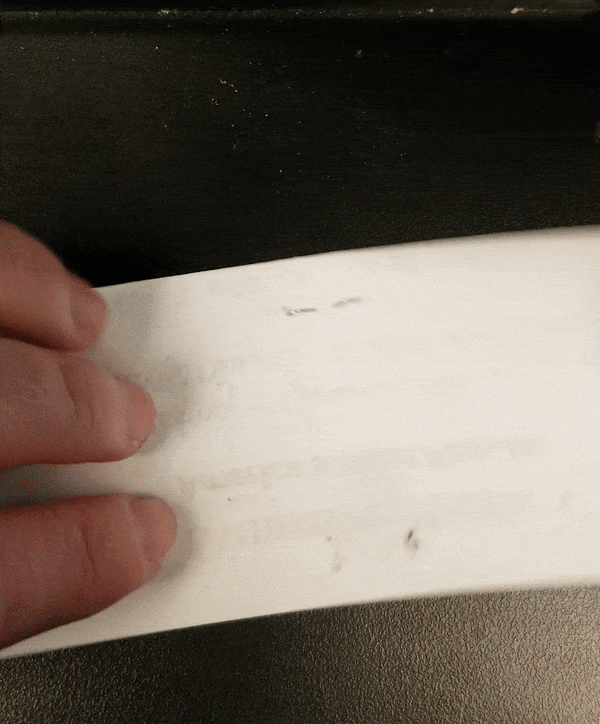
Ashlie, an NCDHC staff member, uses a microspatula to pry up staple legs. License: CC0
Remove staples and fasteners. The caveat here is that you should only do this with materials you’re sure you’re ready to scan. One partner mentioned that staff had removed staples and paperclips from a large quantity of files, but then the project got stalled. Because the vertical files were still in use, this led to papers being misfiled, shuffled out of order, and lost.
- Organize by type then by date. Within each file, organize individual items first by format of item, then by date. Group all of the photographs. Put like sized publications together. Group all of the single page items, all of the clippings. Putting like sized types together will speed up the workflow, saving time when scanning by streamlining your efforts at cropping. Once you’ve grouped things by type, within each group put things in date order (if dates are available). This will help you when you make the scans available.
Suggestion 2: Prepare for the Digital Files
Unless you don’t have that many vertical files (or you have a LOT of time and help) think of each vertical file as a single unit. Here’s what I mean by this. If you have a vertical file about a popular local landmark called the “Turtle Log,” and it includes a few photos, some clippings, and a handwritten narrative, all of those scans would be kept together in a virtual group, folder, or album just as they are in real life. When you describe that group/folder/album either in an internal or online database, you’d describe the unit as a whole, rather than describing each individual photo, clipping, or narrative. This will save a ton of time.
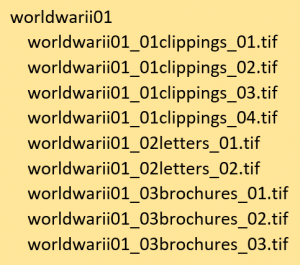 With this in mind, you’ll want to think of a file naming scheme that will keep all of these digital groups organized. Thankfully, file systems mimic files in real life, with the use of folders. Make sure you have a consistent naming convention for files and folders that ensures everything sorts appropriately. On the right is a quick example of how you might decide to name your files. This example is very basic – you could choose to give more detail, include known dates. But note the numbers (01, 02, etc.) included that will make the files sort in order.
With this in mind, you’ll want to think of a file naming scheme that will keep all of these digital groups organized. Thankfully, file systems mimic files in real life, with the use of folders. Make sure you have a consistent naming convention for files and folders that ensures everything sorts appropriately. On the right is a quick example of how you might decide to name your files. This example is very basic – you could choose to give more detail, include known dates. But note the numbers (01, 02, etc.) included that will make the files sort in order.
Suggestion 3: Determine How You’ll Work with Additions
If you intend to keep these vertical files active after scanning, you’ll need to figure out how to denote what’s been scanned and what you’ll do with new additions to the files. A light pencil mark or some other non-permanent note on the back of all scanned items can signal what’s been scanned. Decide if you have the time and staff to scan new additions before filing new donations or if you plan to do that wholesale at a later date. It might also be helpful to have a marker of some sort that you can insert into the file cabinets that lets researchers and staff know about files that have been removed for scanning and whether or not they can still request them.
Suggestion 4: You Should Scan these In House. Or You Shouldn’t.
I wish I could give a single way forward here, but like so many things the answer to whether or not to outsource scanning depends on your situation. Here are a few considerations for the two routes.
Scanning in house. This gives you a lot of flexibility. You can work on the project over time. For active files, they’ll be close at hand if needed. Your staff will gain experience scanning, if they don’t already have it.
Unless you can afford an overhead scanner or camera mount setup, scanning vertical files on a flatbed or other multifunction machine will make a very long process a lot longer. Sheetfed scanners can speed things up a little but only for extremely uniform, non-unique materials that are in good shape. Because the project is large, if you don’t have dedicated scanning staff (or even if you do) be prepared for the contents of multiple file cabinets to take years to scan. You may also need to hire new staff or reskill current staff to do this work, trading this for other duties they currently complete.
Outsourcing scanning. Outsourcing can mean a quicker outcome because the organization doing the scanning will have dedicated workflows and equipment for high volume output. If you don’t have digitization expertise on staff, their expertise can be helpful for avoiding pitfalls.
Unless you are working with an organization that typically scans special collections, the variety of formats can be a challenge and frequently increase the cost. Companies that specialize in corporate files will claim attractively inexpensive prices for scanning but they are frequently used to working with homogenous typing or copy paper. Be sure to interrogate them regarding their expertise, showing them examples and even asking for a quote after they scan a subset. Make sure they offer digital files of a quality and in file formats that you can use into the future.
Suggestion 5: Decide About Your Access Priorities and the Rest will Follow
As we’re fond of saying, digitization is the easy part. Even in a project of this size and complexity, the scanning and preparation of the digital files is more straightforward then what comes next. Here are confounding factors to take into account when you consider how you’ll provide access to the digital vertical files.
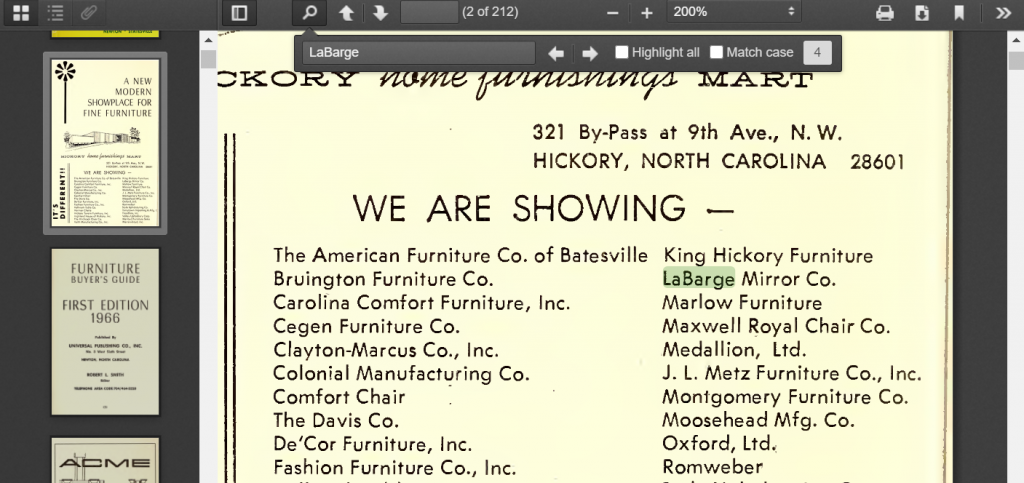 Full Text Search
Full Text Search
Full text search greatly increases the usefulness of digital vertical files. It’s one of the most cited reasons for scanning them in the first place. To be able to search full text within a scanned document, you’ll need to run that digital file through software that recognizes the text and then either embeds it within the file or stores it separately. (Note that this will only happen with typewritten text – accurate automated recognition of handwriting isn’t widely available at this point.) Here are two different options:
- Some institutions choose the PDF format for their vertical files. Software like Adobe Acrobat (not to be confused with the freely available Adobe Reader) will recognize text within a PDF. However PDFs are made for easy transmission and sharing, not for longevity and quality. We recommend that you scan initially to a higher quality or lossless format, and then, if it fits your goals and resources, create derivatives like PDFs. The upside of PDFs is that many desktop and laptop computers can natively search across PDFs. This means you could have them searchable locally, say on a reading room computer, and not necessarily have to provide internet access.
- Alternatively, you can use a system that can store both the text recognized in an image and the image itself and then link them together. Some library or museum catalogs will do this, or you’ll need a content management system. This means additional ongoing costs and the need for technological infrastructure and expertise. But with these types of systems you can provide full text search of your files on the internet.
Copyright and Privacy
Copyright is one of the biggest confounding factors related to making vertical files accessible. Depending on how old your files are, it’s likely that there are materials in there that will be in copyright. If you want to post copyrighted materials on the internet, your organization will need to assess the amount of risk you’re willing to accept. Some items are riskier than others. Regardless, whoever is working on your vertical files will need training and the authority to determine what can and should go online and what should not. Here are a few resources to help get you started:
In addition to copyright, you should always consider privacy concerns. For some of the non-published items in your vertical files, the donations or additions were made with the expectation of local use by a single person or small group. Family history documents that discuss recent events are an example of the type of item you may judge to be too personal for broad consumption without the permission of the creator. There may be documents that share information about communities that would prefer they not be shared broadly. These are all good things to assess as you do your first pass.
Suggestion 6: Find Examples and Friends
Here are some examples of digitized vertical file collections online. These are large projects with a goodly number of staff and funding involved, so take that into account as you look. Note that the files are put online whole rather than breaking out individual items.
This first example comes from the Digital Collections of the University Libraries at UNC-Greensboro and showcases their “class folders.” UNC-G has done quite a bit with vertical files of various types, but this is a great example of folders that have a variety of items grouped by subject. These items are in a system called CONTENTdm, which is specifically designed to host special collections.
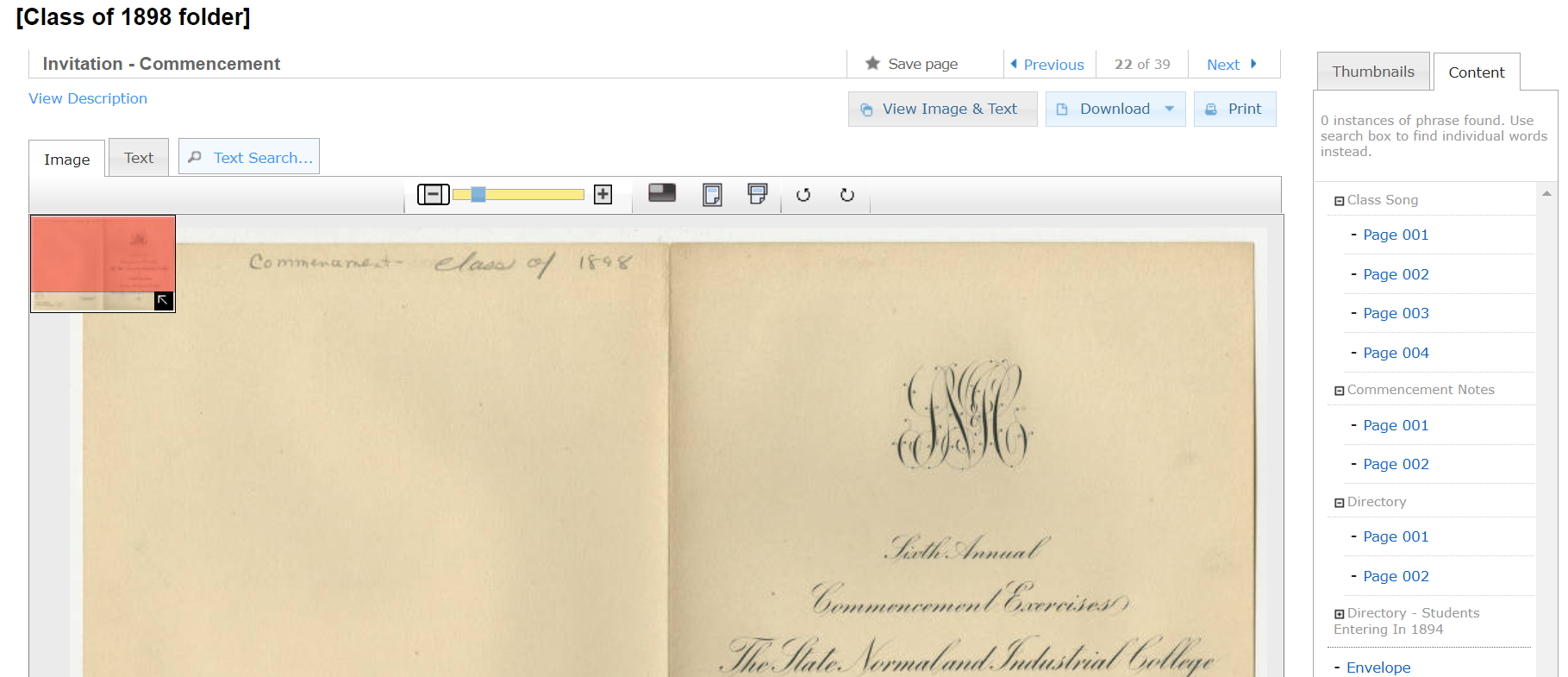
This invitation is one of a number of items in the vertical file entitled “Class of 1898.” You can see the item title at the top and a list of the different items inside on the right.
We’ve also done some vertical files at NCDHC, and you can take a look at an example here. This is from a large collection of vertical files shared by the Kinston Lenoir-County Public Library. Our system is called TIND.
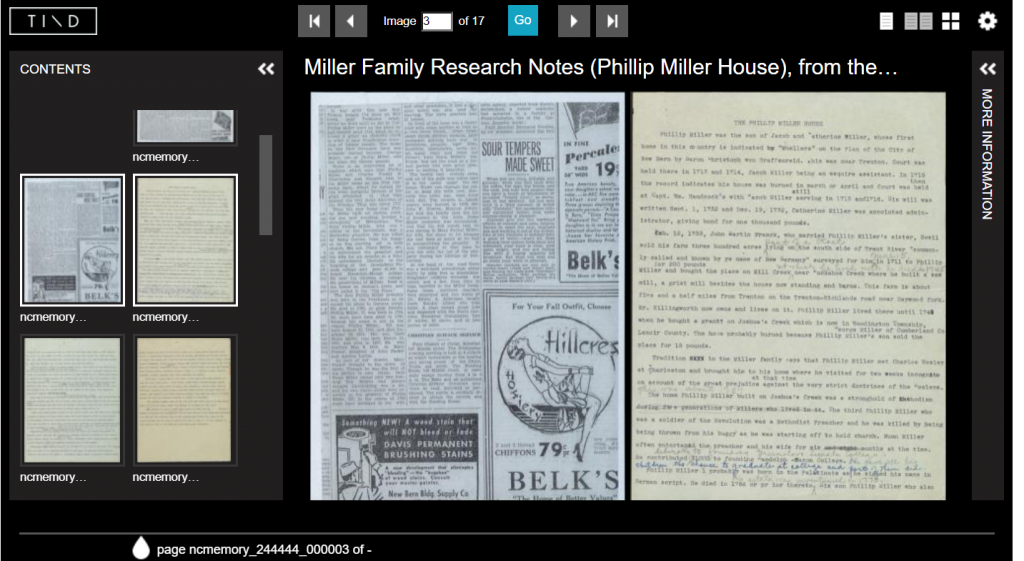
This screenshot shows a large view of a newspaper clipping alongside a typewritten manuscript from the Sybil Hyatt Papers. To the left are thumbnails showing other items in this particular file.
Keep in mind that both of these systems are made for hosting large numbers of special collections items and, like a library or museum catalog, cost money and staff to maintain. While it’s outside of the scope of this article, you can take a look at another post we did regarding how to share your digital files.
For any digitization project, we heartily recommend trying to find friends and peers at area or regional organizations. Ask if they have vertical files or digitization projects (or both?!). A quick phone call or email can help you avoid duplication of effort, at the least, and may gain you advice or a collaboration. You can even choose to share staff or other resources, or collaboratively apply for funding. We also like to be friends! If you’ve made it this far and still want to digitize, but you have questions or would like additional advice, feel free to get in touch.
Thanks to our partner, Randolph County Public Library, the North Carolina College for Women’s (now UNC-Greensboro) 1925 yearbook is now available on our website.
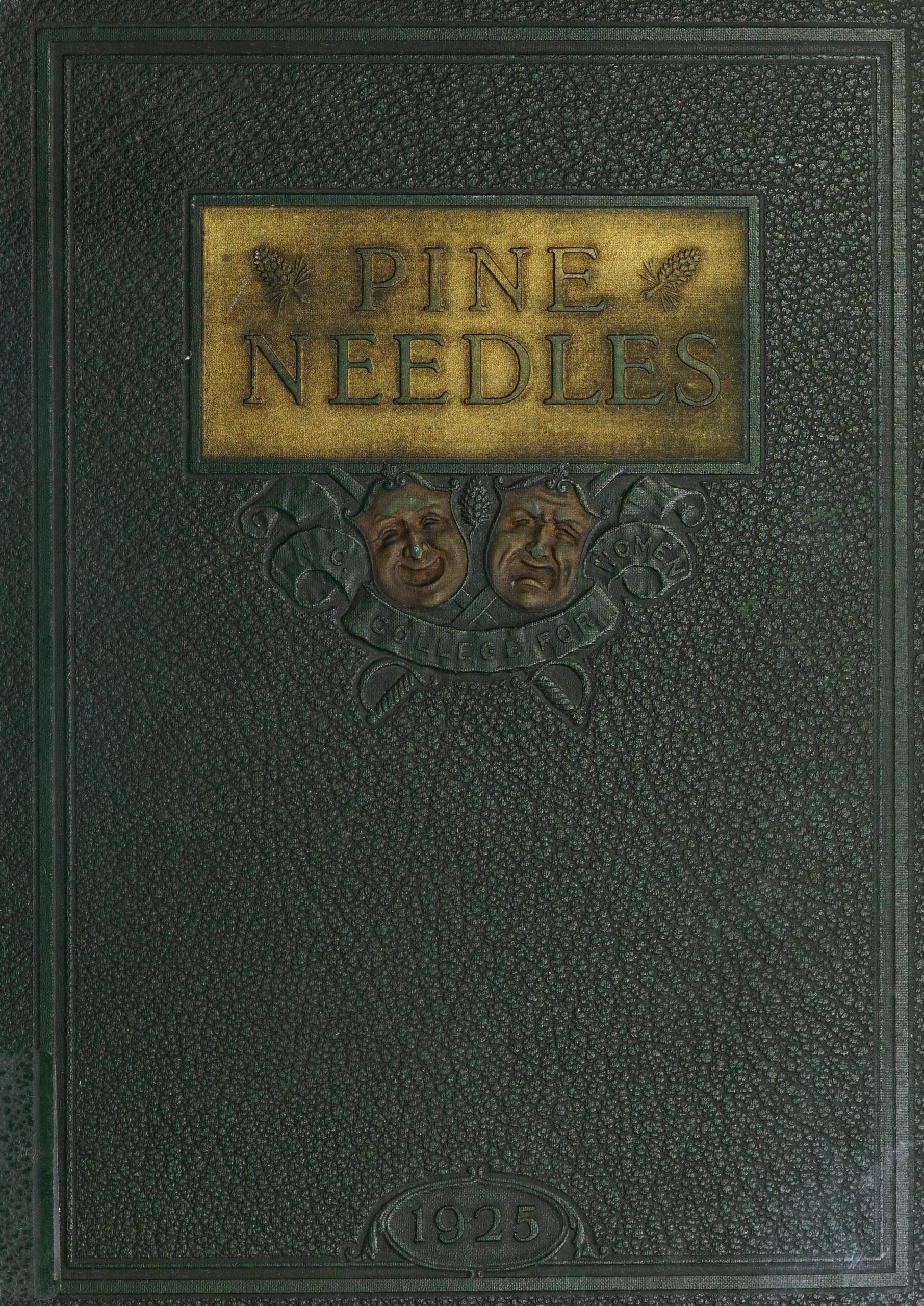
Cover of the 1925 Pine Needles yearbook
To learn more about the Randolph County Public Library, please visit their website.
For more yearbooks from across North Carolina, visit our yearbook collection.

Vicki Coleman, Dean of Library Services at the F. D. Bluford Library, at North Carolina A&T State University
This year marks the North Carolina Digital Heritage Center’s 10th anniversary, and to celebrate we’ll be posting 10 stories from 10 stakeholders about how NCDHC has impacted their organizations.
Today’s 10 for 10 post is from Vicki Coleman, Dean of Library Services at the F. D. Bluford Library, at North Carolina A&T State University. We’ve partnered with NC A&T (Library home page | NCDHC contributor page) to digitize yearbooks, catalogs, and student newspapers. The Library also has their own extensive digital collections online, where you can find faculty research, agricultural history, and history about NC A&T. Read below for more about our partnership with NC A&T.
___
Happy 10th anniversary to the North Carolina Digital Heritage Center!
Over the past decade, the North Carolina Digital Heritage Center (NCDHC) has played a vital role in helping the F.D. Bluford Library at North Carolina Agricultural and Technical State University (NC A&T) ensure the success of its digital conversion projects. More specifically, the NCDHC’s digitization services have aided Bluford Library by providing the infrastructure to create thousands of preservation-quality digital images and other historical materials that are now accessible by students, faculty and researchers world-wide.
Working collaboratively with the NCDHC has opened opportunities for Bluford Library to give visibility to the wealth of history stored in its archive and to the many resources accessible from the DigitalNC website. Listed below are examples of how some digitized collections are used:
- The university’s digitized yearbooks (1939-2013), catalogs and bulletins (1895-2013) and student newspaper (1915-2010) serve as indexes, directing researchers to names, places, photos and historical events that helped shape the university, the surrounding Greensboro community, and the history of African-Americans with regards to higher education and the civil rights movement.
- In 2015, I oversaw the publication of NC A&T’s pictorial history book commemorating the university’s 125th anniversary. When it came to the digitization of some of our most brittle materials for inclusion in the book (e.g., minutes from an 1891 Board of Trustees meeting) it was the NCDHC that got it done.
- Over the past three years, James Stewart, the Archives and Special Collections librarian at Bluford Library, has taught more than 300 students how to access community histories about NC A&T and African-American history via the DigitalNC website.
- This past summer, Mr. Stewart and I conducted research pertaining to the naming of all the buildings and streets on the NC A&T campus. We were able to locate much of the historical information in the A&T Register, the NCA&T student newspaper that was digitized by the NCDHC and by searching the Newspapers collection on the DigitalNC website.
The NCDHC has advanced Bluford Library’s efforts to make historical materials accessible online by providing visionary guidance, high-level expertise and access to state of the art scanning equipment. I appreciate the great skills of the many individuals that make up the NCDHC and look forward to continuing a productive partnership with them. Congratulations to the NCDHC on its tenth anniversary and I await with pleasure another 10 years of remarkable achievements in increasing open access to the state’s cultural heritage.
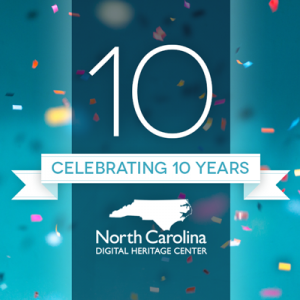
 It’s DigitalNC.org’s 10th birthday! Though we had hoped to be in the office celebrating, we’re still taking time to look back at years of hard work and the collaborative spirit that makes the North Carolina Digital Heritage Center (NCDHC) what it is!
It’s DigitalNC.org’s 10th birthday! Though we had hoped to be in the office celebrating, we’re still taking time to look back at years of hard work and the collaborative spirit that makes the North Carolina Digital Heritage Center (NCDHC) what it is!
To date, NCDHC has partnered with 273 libraries, museums, alumni associations, archives, and historic sites in 98 of North Carolina’s 100 counties and we’re growing all the time. Our website currently includes 4.2 million images and files. We share this accomplishment with every institution we’ve worked with. We’d never have gotten to 10 years without staff (permanent, temporary, and student!), our partners, or the network of colleagues all over North Carolina who have encouraged, advised, and supported our work.
As we approached our anniversary, we realized that our website lacked a synopsis of how NCDHC came to be, and our history. So read on for a brief look at how we got started and our major milestones.
Our History
The North Carolina Digital Heritage Center was one outcome of a comprehensive effort by the state’s Department of Cultural Resources (now the Department of Natural and Cultural Resources) to survey and get a broad overview of the status of North Carolina cultural heritage institutions. That effort was entitled NC ECHO (North Carolina Exploring Cultural Heritage Online) and was funded by the Institute of Museum and Library Services (which also supports us – thanks IMLS). A major goal of NC ECHO was a multi-year needs assessment. NC ECHO staff visited hundreds of cultural heritage institutions throughout the state to collect data and interview curators, librarians, volunteers, archivists, and more. Many of our partners still remember their visits!
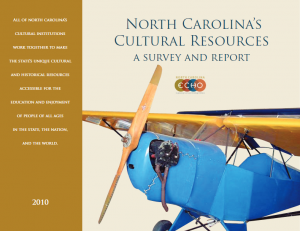 Data collected at these site visits was combined with survey responses to reveal a “state of the state,” summarized in a 2010 report, cover pictured at right. The assessment revealed a lot but, specific to digitization, staff found that nearly three-quarters of the 761 institutions who completed the survey had no digitization experience or capacity. Members of the Department of Cultural Resources (which includes the State Library, State Archives, and multiple museums and historic sites) began brainstorming with other area institutions about a way to help efficiently and effectively provide digitization opportunities. While the NC ECHO project offered digitization grants, workshops, and best practices, an idea emerged of a centralized entity that could assist institutions that didn’t have the capacity to do the work in house. The State Library of North Carolina and UNC-Chapel Hill Libraries joined together to create such an entity: the North Carolina Digital Heritage Center. The Center would be located in Chapel Hill, taking advantage of its central location and the digitization equipment and expertise already available in Wilson Special Collections Library. The State Library would provide funding, guidance, and ongoing promotion and support of the Center’s services.
Data collected at these site visits was combined with survey responses to reveal a “state of the state,” summarized in a 2010 report, cover pictured at right. The assessment revealed a lot but, specific to digitization, staff found that nearly three-quarters of the 761 institutions who completed the survey had no digitization experience or capacity. Members of the Department of Cultural Resources (which includes the State Library, State Archives, and multiple museums and historic sites) began brainstorming with other area institutions about a way to help efficiently and effectively provide digitization opportunities. While the NC ECHO project offered digitization grants, workshops, and best practices, an idea emerged of a centralized entity that could assist institutions that didn’t have the capacity to do the work in house. The State Library of North Carolina and UNC-Chapel Hill Libraries joined together to create such an entity: the North Carolina Digital Heritage Center. The Center would be located in Chapel Hill, taking advantage of its central location and the digitization equipment and expertise already available in Wilson Special Collections Library. The State Library would provide funding, guidance, and ongoing promotion and support of the Center’s services.
At its beginning, the Center’s staff digitized small collections of college yearbooks, needlework samplers, postcards, and photographs and made them available through DigitalNC.org. They went to speak with organizations interested in becoming partners, and began taking projects for digitization. Here’s a list of NCDHC’s earliest partners, who came on board during late 2009 and 2010.
Though we’re not positive of the exact date, we believe DigitalNC.org launched on or near May 12, 2010. Here’s a look at that original site!
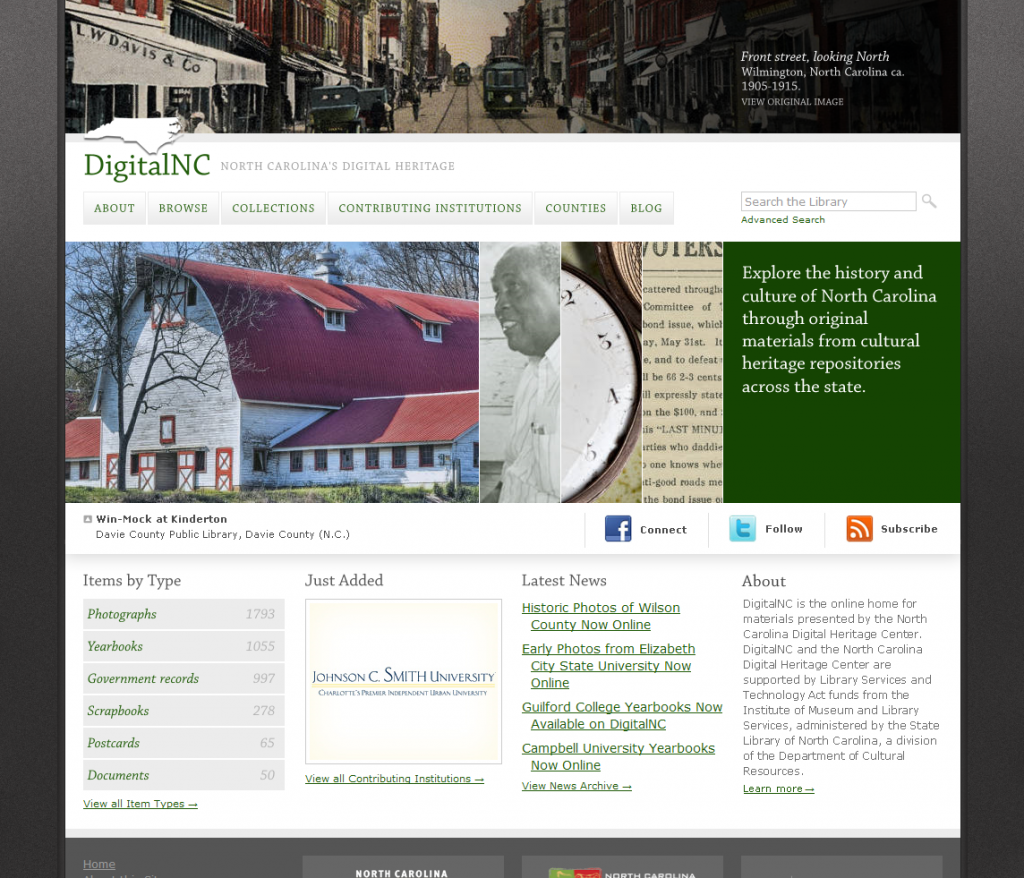
In 2011, word about the Center spread. Staff started responding to demand from partners, incorporating newspaper digitization. In late 2012, also in response to popular demand, the Center began digitizing high school yearbooks. Yearbooks and newspapers are some of the most viewed items on DigitalNC, and they remain a significant portion of our work to this day.
In 2013, NCDHC joined the Digital Public Library of America (DPLA) as North Carolina’s “service hub.” The DPLA collects information from digitized collections all over the nation and provides it together in one searchable interface at dp.la. Because of our participation, users can browse and search for collections from North Carolina alongside items from institutions around the country.
Throughout the years, we’ve tried to expand services to fit our partners’ goals. In 2015, we trialed an audiovisual digitization project that incorporated the first films into DigitalNC. Today, we partner with the Southern Folklife Collection at Wilson Special Collections Library to provide audio digitization on an ongoing basis. In 2016, we added a new partner category – alumni associations – to support more digitization of African American high school yearbooks and memorabilia. The following year, we announced a focus on digitization of items documenting underrepresented communities. We also started going on the road with our scanners! For institutions that don’t have the staff time or resources to travel to Chapel Hill, we offer to come for a day or two and scan on site.
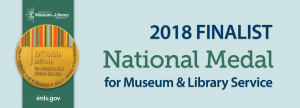 2018 and 2019 saw several major milestones. We were nationally recognized as an Institute of Museum and Library Services National Medal finalist, and we began a major software migration. Both were a tribute to the size and extent of our operation, though in different ways. As we’ve approached our 10th anniversary we’ve focused on working with partners in all 100 of North Carolina’s counties. Whether you’re rural or metropolitan, we believe your history is important and should be shared online.
2018 and 2019 saw several major milestones. We were nationally recognized as an Institute of Museum and Library Services National Medal finalist, and we began a major software migration. Both were a tribute to the size and extent of our operation, though in different ways. As we’ve approached our 10th anniversary we’ve focused on working with partners in all 100 of North Carolina’s counties. Whether you’re rural or metropolitan, we believe your history is important and should be shared online.
One of the ways we’re commemorating this anniversary is to ask our partners and stakeholders how they think we’ve impacted them and their audiences. Join us here on the blog in the second half of 2020 as we share these brief interviews, reflect, and celebrate. Thank you for reading, enjoy the site, and here’s to another 10 years of making North Carolina’s cultural heritage accessible online!






























